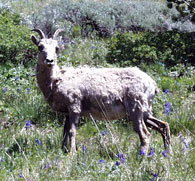- Bighorn
Sheep
- Bighorn
sheep are also called mountain sheep. They
are part of the cattle, goat, and sheep
family. Sheep have the ability to climb
and jump.
|

|
What
does a bighorn sheep look like?
|
Male bighorn
sheep are called rams. They stand about 3
feet tall and are 5 to 6 feet long. They
weigh about 200 to 300 pounds. Females are
called ewes. Ewes are smaller than
rams.
|

|
Bighorn sheep
have excellent eyesight. Their fur is gray, brown, or
tan. Their underbelly, rear end, and eye patches are
light colored. In the summer, they shed the top level
of their fur. Their horns are brown color and grow
throughout their life. As rams grow old, their horns
curl. Bighorn sheep have a muscular body with a very
thick neck. -
- Their hooves are made
for mountain climbing. Bighorn sheep follow narrow
trails over mountainsides and steep slopes. Bighorn
are also good swimmers.
-
- Ewes have one baby in
the spring. Baby sheep are called lambs.

|
- What
do bighorn sheep eat?
Bighorn sheep
eat grass. They get their water from mountain
pools or by eating snow. They feed in early
morning, at midday, and in the
evening.
|

|
- Where
can I find a bighorn sheep?
In
the summer, bighorn sheep go to the high
mountain slopes. In the winter, they return
to the foothills at the bottom of the
mountains. Bighorns
are found
on high, rugged mountain slopes. You often
see them on cliffs and wooded
canyons.
|
In spring, males and females move in separate bands
to the high mountains. In fall, the rams join bands of
ewes. In the winter, they all group together.
-
- Bighorn sheep are
found in the mountain ranges of southern California,
Arizona, and New Mexico northward through Idaho and
Montana and on into British Columbia.
-
- Who
are the friends and enemies of a bighorn
sheep?
- Bighorn sheep have
many enemies such as cougars, golden eagles, wolves,
coyotes, bears, bobcats, and lynx. On cliffs, adult
bighorns can easily escape all but the cougars. Golden
eagles attack young lambs whenever they find them
unprotected.
|
Disease,
hunting, and overgrazing of livestock have
pushed the bighorn sheep into a few mountain
preserves. Notable herds do still roam the
mountain slopes of Yellowstone
and Glacier
national parks.
|

|
-
- Where
can I find more information?
- For more information
about bighorn sheep, visit these sites:
- Bighorn
Mountain Sheep
(British Columbia Adventure Network)
- http://www.fishbc.com/adventure/wilderness/anim
- als/bighorn.htm
- Here you can
find information on the description, tracks,
habitat, and behavior of bighorn
sheep.
-
- Rocky
Mountain Bighorn
- http://metronet.syr.edu/projects/cyberzoo/animals/
- bighornsheep.html
- This student
project webpage provides pictures, information,
and a drawing of the Rocky Mountain Bighorn
Sheep.
-
- Sierra
Nevada Bighorn
Sheep by
Robin Meadows
- http://fonz.org/zoogoer/zg1999/28(3)sheep.htm
- A May/June 1999
article in Zoogoer magazine outlines the plight
of a dwindling bighorn sheep population in
Califorinia's Sierra Nevada
Mountains.
-
- Bighorn
Sheep
(Teachers' Corner)
- http://www.specialspecies.com/Pages/teachers_co
rner/bighorn_sheep/bighorn.html
- Site developed
for teachers contains links to other bighorn
sheep websites.
-
 - Return
to NatureScapes
-
- Note: All photographs were
taken with a digital camera in Rocky Mountain National
Park (Colorado), Hells Canyon (Idaho), and Yellowstone
National Park (Wyoming) during July and August,
1999.
- Developed by
Annette
Lamb and
Larry
Johnson,
6/99.
- Updated 12/99
|